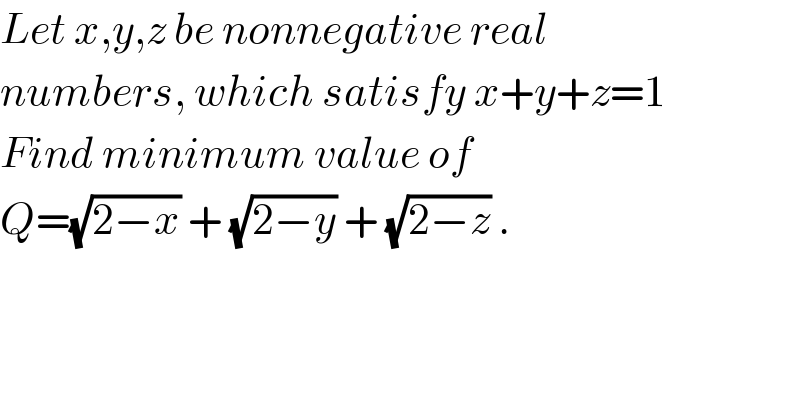
Question and Answers Forum
Question Number 119790 by bemath last updated on 27/Oct/20

Answered by 1549442205PVT last updated on 27/Oct/20
))))∣_(((1/3),(1/3))) =((−9)/( 5(√(15))))−(9/(5(√(15))))=((−18)/(5(√(15))))<0 C=(∂^2 Q/∂b^2 )∣_(((1/3),(1/3))) =((−1)/((1+2b)(√(1+2b))))−(1/([3−2(a+b)](√(3−2(a+b)))))∣_(((1/3),(1/3))) =((−18)/( (√(515))))<0 (∂^2 Q/(∂a∂b))∣_(((1/3),(1/3))) =(∂Q/∂b)((1/( (√(1+2a))))−(1/( (√(3−2(a+b)))))) B=(1/( (√(3−2(a+b)))))∣_(((1/3),(1/3))) =(3/( (√(15)))) Δ=AC−B^2 =[((18)/( 5(√(15))))]^2 −(9/(15))=((324−225)/(25.15))>0 Since A<0,Q has maximum Q_(max) =Q((1/3),(1/3))=(√(15 )) when(x,y,z) =((1/3),(1/3),(1/3)) On the other hand, consider Q(x,y,z) at the bounded points we have Q(0,1,0)=Q(0,1,0)=Q(0,0,1)= =1+2(√2)=3.828..<(√(15)) ≈3.873 Q((1/2),(1/2),0)=(√2)+(√6)≈3.8637>1+2(√2) Comparing the above values we see Tthe smallest value of Q equal to 1+2(√2) when (x,y,z)=(0,0,1) and all the its permutation](Q119796.png)
Answered by ebi last updated on 27/Oct/20

| ||
Question and Answers Forum | ||
Question Number 119790 by bemath last updated on 27/Oct/20 | ||
 | ||
Answered by 1549442205PVT last updated on 27/Oct/20 | ||
))))∣_(((1/3),(1/3))) =((−9)/( 5(√(15))))−(9/(5(√(15))))=((−18)/(5(√(15))))<0 C=(∂^2 Q/∂b^2 )∣_(((1/3),(1/3))) =((−1)/((1+2b)(√(1+2b))))−(1/([3−2(a+b)](√(3−2(a+b)))))∣_(((1/3),(1/3))) =((−18)/( (√(515))))<0 (∂^2 Q/(∂a∂b))∣_(((1/3),(1/3))) =(∂Q/∂b)((1/( (√(1+2a))))−(1/( (√(3−2(a+b)))))) B=(1/( (√(3−2(a+b)))))∣_(((1/3),(1/3))) =(3/( (√(15)))) Δ=AC−B^2 =[((18)/( 5(√(15))))]^2 −(9/(15))=((324−225)/(25.15))>0 Since A<0,Q has maximum Q_(max) =Q((1/3),(1/3))=(√(15 )) when(x,y,z) =((1/3),(1/3),(1/3)) On the other hand, consider Q(x,y,z) at the bounded points we have Q(0,1,0)=Q(0,1,0)=Q(0,0,1)= =1+2(√2)=3.828..<(√(15)) ≈3.873 Q((1/2),(1/2),0)=(√2)+(√6)≈3.8637>1+2(√2) Comparing the above values we see Tthe smallest value of Q equal to 1+2(√2) when (x,y,z)=(0,0,1) and all the its permutation](Q119796.png) | ||
| ||
Answered by ebi last updated on 27/Oct/20 | ||
 | ||
| ||